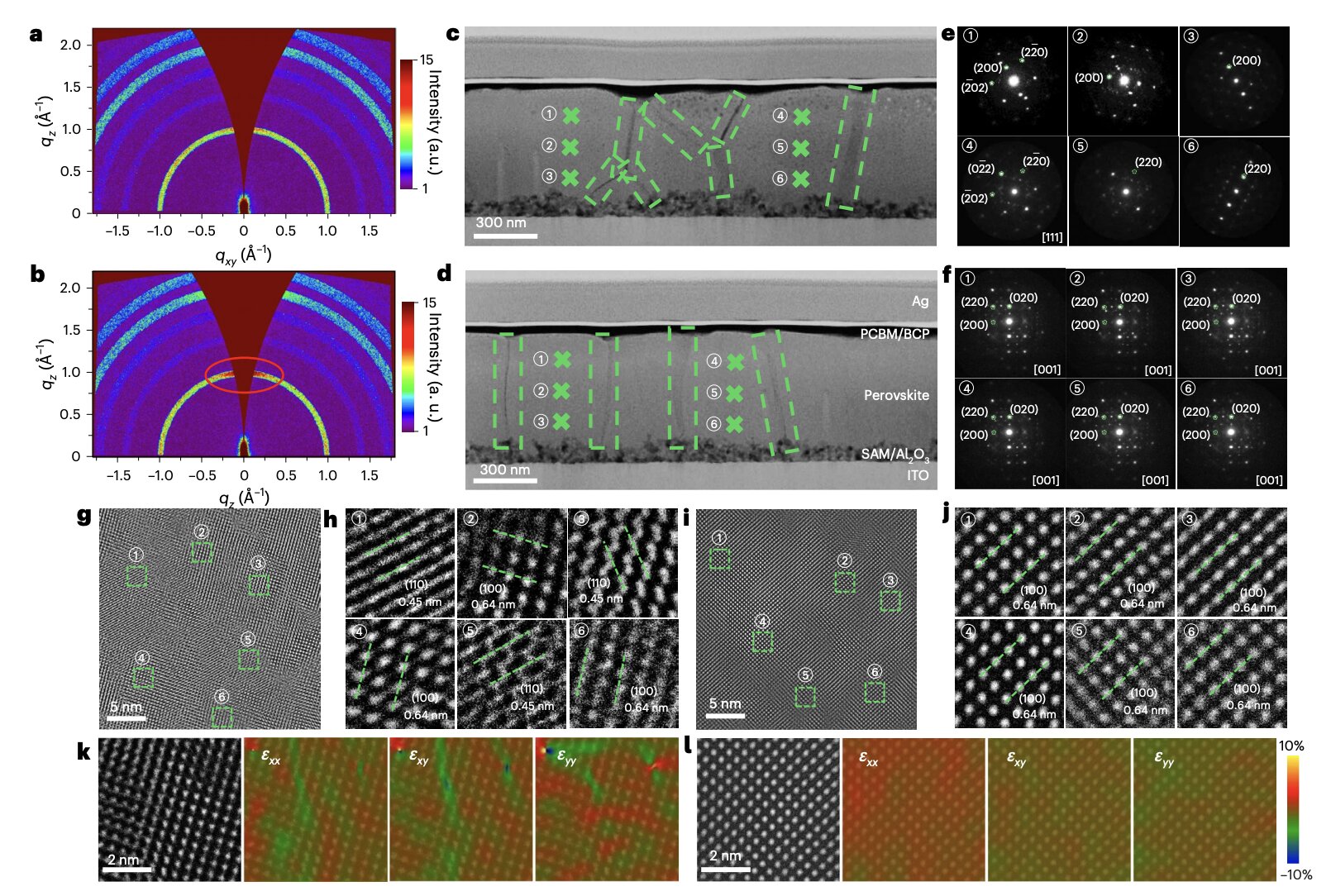Tech
Molecular engineering strategy boosts efficiency of inverted perovskite solar cells

Solar cells, devices that can directly convert radiation emitted from the sun into electricity, have become increasingly widespread and are contributing to the reduction of greenhouse gas emissions worldwide. While existing silicon-based solar cells have attained good performances, energy engineers have been exploring alternative designs that could be more efficient and affordable.
Perovskites, a class of materials with a characteristic crystal structure, have proved to be particularly promising for the development of low-cost and energy-efficient solar energy solutions. Recent studies specifically highlighted the potential of inverted perovskite solar cells, devices in which the extraction charge layers are arranged in the reverse order compared to traditional designs.
Inverted perovskite solar cells could be more stable and easier to manufacture on a large-scale than conventional perovskite-based cells. Nonetheless, most inverted cells developed so far were found to exhibit low energy-efficiencies, due to the uncontrolled formation of crystal grains that can produce defects and adversely impact the transport of charge carriers generated by sunlight.
Researchers at Huazhong University of Science and Technology recently devised a new molecular engineering strategy to control the crystallization of perovskite materials in inverted solar cells. This promising approach, outlined in a paper published in Nature Energy, entails mixing special naphthalene-based molecules into perovskites, to ensure that they grow more uniformly.
“Formamidinium and cesium metal halide perovskites enable high efficiency in inverted perovskite solar cells, but uncontrolled crystallization limits their performance,” wrote Qisen Zhou, Guoyu Huang and their colleagues in their paper. “We regulate the nucleation and growth of the perovskite through aromatic interactions between naphthalene ammonium salts and naphthalenesulfonates.”
Essentially, the researchers mixed naphthalene-based molecules into the perovskite solution to control the formation and growth of perovskite crystals. They found that the resulting perovskite films were uniform and had very few defects, which is highly favorable for the development of inverted solar cells.
“The ammonium groups of the naphthalene ammonium salts occupy the formamidinium site, while the sulfonate groups of the naphthalenesulfonates coordinate with lead ions,” explained the authors. “Their naphthalene moieties form tight aromatic stacking adjacent to the [PbI6]4− octahedra. These interactions promote ordered out-of-plane crystallization along the (100) plane, enhancing defect passivation and carrier transport.”
Zhou, Huang and his colleagues used the uniform perovskite films they created to fabricate inverted perovskite solar cells. They then tested the performance, efficiency and stability of these cells under continuous illumination.
“We achieve a power conversion efficiency of 27.02% (certified 26.88%) for inverted solar cells,” wrote the researchers. “Encapsulated devices retain 98.2% of their initial efficiency after 2,000 h of maximum power point tracking under continuous illumination in ambient air. Furthermore, we demonstrate a certified steady-state efficiency of 23.18% for inverted mini-modules with an aperture area of 11.09 cm2 and a certified efficiency of 29.07% for all-perovskite tandem solar cells.”
The initial results gathered by this research team are highly promising, highlighting the promise of their molecular engineering approach for the development of energy-efficient inverted perovskite solar cells. In the future, their strategy could be further refined to achieve additional efficiency gains and used to realize high-quality perovskite films with varying compositions.
Written for you by our author Ingrid Fadelli, edited by Lisa Lock, and fact-checked and reviewed by Robert Egan—this article is the result of careful human work. We rely on readers like you to keep independent science journalism alive.
If this reporting matters to you,
please consider a donation (especially monthly).
You’ll get an ad-free account as a thank-you.
More information:
Qisen Zhou et al, Aromatic interaction-driven out-of-plane orientation for inverted perovskite solar cells with improved efficiency, Nature Energy (2025). DOI: 10.1038/s41560-025-01882-x
© 2025 Science X Network
Citation:
Molecular engineering strategy boosts efficiency of inverted perovskite solar cells (2025, October 28)
retrieved 28 October 2025
from https://techxplore.com/news/2025-10-molecular-strategy-boosts-efficiency-inverted.html
This document is subject to copyright. Apart from any fair dealing for the purpose of private study or research, no
part may be reproduced without the written permission. The content is provided for information purposes only.
Tech
Is AI ready for the courtroom? New framework tackles the technology’s biggest weaknesses

For over a decade, computer scientist Randy Goebel and his colleagues in Japan have been using a tried-and-true method from his field to advance artificial intelligence in the world of law: a yearly competition.
Drawing on example legal cases taken from the Japanese bar exam, contestants must use an AI system that can retrieve statutes relevant to the cases, and, more crucially, make a decision: did the defendants in the cases break the law, or not?
It’s this yes/no answer that AI struggles with the most, says Goebel—and it raises questions of whether AI systems can be ethically and effectively deployed by lawyers, judges and other legal professionals who face giant dockets and narrow time windows to deliver justice.
The contest has provided the foundation for a new paper in which Goebel and his co-authors outline the types of reasoning AI must use to “think” like lawyers and judges, and describe a framework for imbuing large language models (LLMs) with legal reasoning.
The paper is published in the journal Computer Law & Security Review.
“The mandate is to understand legal reasoning, but the passion and the value to society is to improve judicial decision-making,” Goebel says.
The need for these kinds of tools has been especially critical since the Supreme Court of Canada’s Jordan decision, Goebel says. That decision shortened the length of time prosecutors have to bring a case to trial, and it has resulted in cases as severe as sexual assault and fraud being thrown out of court.
“It’s a very good motivation to say, ‘Let’s enable the judicial system to be faster, more effective and more efficient,'” Goebel says.
Making machines ‘think’ like lawyers
The paper highlights three types of reasoning AI tools must possess to think like legal professionals: case-based, rule-based and abductive reasoning.
Some AI systems, such as LLMs, have proven adept at case-based reasoning, which requires legal experts to examine previous court cases and determine how laws were applied in the past to draw parallels to the current case in question.
Rule-based reasoning, which involves applying written laws to unique legal cases, can also be completed to some extent by AI tools.
But where AI tools struggle the most is with abductive reasoning, a type of logical inference that involves stringing together a plausible series of events that could explain, for example, why a defendant is not guilty of a crime. (Did the man with the knife in his hand stab the victim? Or did a gust of wind blow the knife into his hand?)
“Not surprisingly, abductive reasoning can’t be done by modern large language models, because they don’t reason,” Goebel says. “They’re like your friend who has read every page of Encyclopedia Britannica, who has an opinion on everything but knows nothing about how the logic fits together.”
Combined with their tendency to “hallucinate,” or invent “facts” wholesale, generic LLMs applied to the legal field are at best unreliable and, at worst, potentially career-ending for lawyers.
The important challenge for AI scientists is whether they can develop a reasoning framework that works in conjunction with generic LLMs to focus on accuracy and contextual relevance in legal reasoning, Goebel says.
No one-size-fits-all AI tool
When will we have AI tools that can cut the work of lawyers and judges in half? Perhaps not any time soon.
Goebel says a key takeaway from the competition, and one that is also outlined in the paper, is that using computer programs to aid legal decision-making is relatively new, and there is still a lot of work to be done.
Goebel foresees many separate AI tools employed for different types of legal tasks, rather than a single “godlike” LLM.
Claims made by some in the AI industry that humanity is on the cusp of creating an AI tool that can render “perfect” judicial decisions and legal arguments are absurd, Goebel says.
“Every judge I’ve spoken to has acknowledged there is no such thing as perfect judgment,” he says. “The question is really, ‘How do we determine whether the current technologies provide more value than harm?'”
More information:
Ha Thanh Nguyen et al, LLMs for legal reasoning: A unified framework and future perspectives, Computer Law & Security Review (2025). DOI: 10.1016/j.clsr.2025.106165
Citation:
Is AI ready for the courtroom? New framework tackles the technology’s biggest weaknesses (2025, October 28)
retrieved 28 October 2025
from https://techxplore.com/news/2025-10-ai-ready-courtroom-framework-tackles.html
This document is subject to copyright. Apart from any fair dealing for the purpose of private study or research, no
part may be reproduced without the written permission. The content is provided for information purposes only.
Tech
The Republican Plan to Reform the Census Could Put Everyone’s Privacy at Risk

President Donald Trump and the Republican Party have spent the better part of the president’s second term radically reshaping the federal government. But in recent weeks, the GOP has set its sights on taking another run at an old target: the US census.
Since the first Trump administration, the right has sought to add a question to the census that captures a respondent’s immigration status and to exclude noncitizens from the tallies that determine how seats in Congress are distributed. In 2019, the Supreme Court struck down an attempt by the first Trump administration to add a citizenship question to the census.
But now, a little-known algorithmic process called “differential privacy,” created to keep census data from being used to identify individual respondents, has become the right’s latest focus. WIRED spoke to six experts about the GOP’s ongoing effort to falsely allege that a system created to protect people’s privacy has made the data from the 2020 census inaccurate.
If successful, the campaign to get rid of differential privacy could not only radically change the kind of data made available, but could put the data of every person living in the US at risk. The campaign could also discourage immigrants from participating in the census entirely.
The Census Bureau regularly publishes anonymized data so that policymakers and researchers can use it. That data is also sensitive: Conducted every 10 years, the census counts every person living in the United States, citizen and noncitizen alike. The data includes detailed information like the race, sex, and age, as well the languages they speak, their home address, economic status, and the number of people living in a house. This data is used for allocating the federal funds that support public services like schools and hospitals, as well as for how a state’s population is divided up and represented in Congress. The more people in a state, the more Congressional representation—and more votes in the Electoral College.
As computers got increasingly sophisticated and data more abundant and accessible, census employees and researchers realized the data published by the Census Bureau could be reverse engineered to identify individual people. According to Title XIII of the US Code, it is illegal for census workers to publish any data that would identify individual people, their homes, or businesses. A a government employee revealing this kind of information could be punished with thousands of dollars in fines or even a possible prison sentence.
For individuals, this could mean, for instance, someone could use census data without differential privacy to identify transgender youth, according to research from the University of Washington.
Tech
This Is the Nuclear-Powered Ship Deployed in Trump’s War on Drug Boats

The USS Gerald R. Ford, the US Navy’s most advanced aircraft carrier, is heading to the Caribbean Sea as part of a Pentagon strategy it says is meant to strengthen the fight against drug trafficking in South America.
The news was confirmed late last week by Sean Parnell, assistant secretary of defense for public affairs, through his social networks. In his message, he explained that the deployment of the Gerald R. Ford “will strengthen the United States’ ability to detect, monitor and dismantle illicit actors and activities that compromise the security and prosperity of US territory, as well as our stability in the Western Hemisphere.” Until now, only combat vessels and aircraft had been mobilized in the area.
Since last month, President Donald Trump’s administration has maintained a campaign in Caribbean waters aimed at combating drug trafficking, arguing that the activity of various criminal organizations puts the security of the American people at risk. In recent weeks, the US armed forces have targeted several vessels and accused their operators of transporting drugs, a situation that has increased US diplomatic tensions with nations such as Venezuela and Colombia.
The dispatch of the Ford represents an escalation of Washington’s military activity in the region, which, according to specialists, could further increase hostilities.
The Ford has been described as the most advanced and expensive in the world. Its construction had an estimated value of $13 billion, according to military industry press. It is the first of a new generation of aircraft carriers destined to replace the Nimitz class, which since the 1970s has been the mainstay of the US fleet.
The site Naval Technology explains that the Ford class comprises nuclear-powered aircraft carriers, developed by the Newport News Shipbuilding division of Huntington Ingalls Industries for the US Navy as part of the CVN-21 Aircraft Carrier Program.
Bring in the Big Guns
Compared to the Nimitz class, the USS Gerald R. Ford incorporates 23 new or improved systems that optimize transportation, communication, tracking, operational performance, weight tolerance and stability functions, among other aspects.
The ship displaces nearly 100,000 tons, is 333 meters long and 40.8 meters wide, and has a flight deck 78 meters wide. One of its main innovations is its advanced nuclear propulsion system, which improves power generation and distribution by 150 percent over its predecessors. This system, developed by Northrop Grumman, is composed of two reactors, four shafts, and a zonal electrical distribution system, allowing it to sail for up to 20 years without refueling.
The ship operates with the Electromagnetic Aircraft Launch System, considered its greatest innovation. This mechanism replaces the traditional steam catapults with a linear electromagnetic accelerator motor, which improves control in the acceleration of manned and unmanned aircraft. In practice, it allows vehicles to be launched at higher speeds, with heavier weaponry or more fuel, extending their range, coverage, and lethality.
-

 Fashion1 week ago
Fashion1 week agoChinese woman charged over gold theft at Paris Natural History Museum
-

 Tech7 days ago
Tech7 days agoThis Smart Warming Mug Is Marked Down by $60
-

 Fashion1 week ago
Fashion1 week agoeBay UK seller fee removal sends revenue down but profits rise
-

 Entertainment1 week ago
Entertainment1 week agoJohn Grisham unveils his first-ever mystery, “The Widow”
-

 Tech1 week ago
Tech1 week agoEaster Island’s Moai Statues May Have Walked to Where They Now Stand
-

 Tech1 week ago
Tech1 week agoOpenAI has slipped shopping into ChatGPT users’ chats—here’s why that matters
-

 Fashion1 week ago
Fashion1 week agoNew EU strategy proposed to shape global clean, resilient transition
-

 Business1 week ago
Business1 week agoDhanteras Engine Fires Up Auto Market: Over 1 lakh Cars Delivered In 24 Hours


















